There are a lot of fine motor activities here on The OT Toolbox. On these fine motor skills examples all over the website, you’ll find a lot of descriptions of what the term actually means. I wanted to create a space that clearly breaks down the definition of fine motor skills and covers what are fine motor skills and how they all work together in functional tasks. These are the foundations of fine motor, broken down into specific skills.
What are Fine Motor Skills?
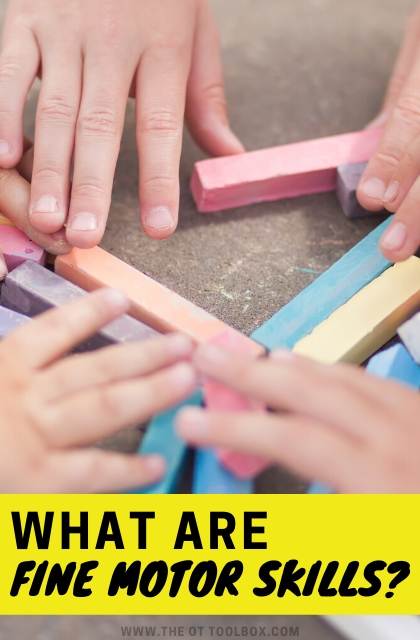
Scroll through Pinterest and you will see activity after activity that claims to improve fine motor skills or help with fine motor development…however, have you really found a resource that defines exactly how fine motor development occurs through play activities? This Fine motor list can be helpful in better understanding the activities we set up for kids so we can define fine motor skills and its meaning in play!
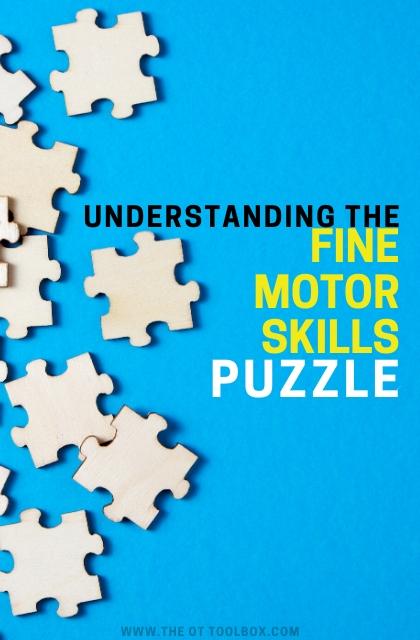
Why are fine motor skills important?
The OTs in the room know this process, of course. Read on to better understand the underlying fine motor skills play into activities such as holding a pencil, cutting with scissors, turning the page of a book, opening a snack baggie, zippering a coat, and every other task we complete throughout the day.
Our hands are amazing tools. They help us get dressed, write down important information, open containers, hold utensils, and many other daily tasks. To support our success in completing these tasks, we must first develop the necessary fine motor skills. These skills can be broken down into in-hand manipulation skills, dexterity, web space and arches of the hands. Without these skills, our daily lives would be much more difficult.
Fine Motor Skills and Examples

In-Hand Manipulation Skills- In-hand manipulation skills refer to the ability to move our fingers in a series of three dynamic patterns that include translation, shift, and rotation. A major component of in-hand manipulation skills is that they are completed with ONE hand. If the other hand is utilized for support, it is not longer an in-hand manipulation skill and the child may be experiencing a delayed skills. In-hand manipulation skills support our abilities to manipulate pencils, fasteners, tie our shoes and open packages with ease. Still other tasks include managing a fistful of small items such as sand, beads, dry beans, and play activities. Here is an in-hand manipulation activity, and here is another in-hand manipulation activity to work on these fine motor skills.
Translation– Translation is the ability to move an item from the bottom of the palm, the top of palm and back. We use this pattern for giving out change, and “squirrelling” away multiple buttons, beads or other small items into our hand without dropping them. Translation supports fluid movement of the joints in the fingers, and separation of the two sides of the hand needed for dynamic finger patterns used in everyday activities. Translation includes two types of movement:
- Finger-to-Palm Translation: Movement of an object from the fingers to the palm i.e. picking up a coin and moving it to the palm.
- Palm-to-Finger Translation: Movement of an object from the palm to the finger tips. (i.e. moving a coin from the palm to the fingertips to insert into a vending machine.)
Translation is needed for tasks including manipulating coins or moving money within the hands.

Shift- Shift allows us to move our fingers into position on the pencil to allow for optimal control of the eraser, or allow us to push a string through a bead. This movement pattern is often described as looking like your fingers are “walking” in a linear fashion from one end of the pencil to the other.

Rotation– Spinning a pencil with one had to use the eraser, spinning a coin or flipping a card over to what’s on the other side. When describing the movement pattern of rotation is defined, it is defined as moving an item in a circular pattern on an axis. Rotation includes two types of movement needed for fine motor activities:
- Simple Rotation: Turning or rolling an object 90 degrees or less with the fingers moving as a unit (i.e. unscrewing a toothpaste lid, or spinning a pencil to adjust when erasing or getting a pencil comfortable in the grip).
- Complex Rotation: Turning an object more than 90 degrees using isolated finger and thumb movements (i.e. Turning a paper clip, or turning a pencil over to erase). Use these other games with paper clips to support various fine motor skills.
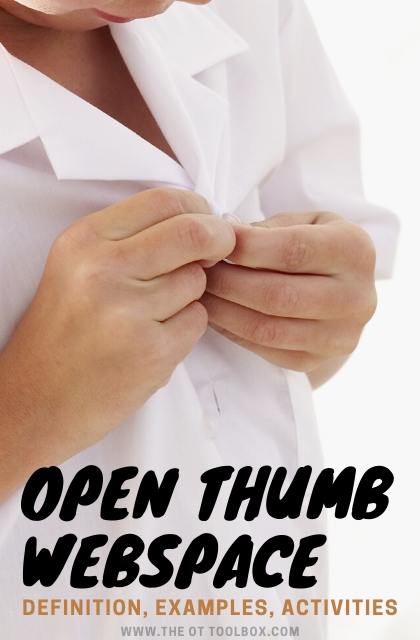
Web Space– The area of the hand that is referred to as the web space is the distance between thumb and the index finger. When this area is not very large or is restricted due to malformations or tone, dexterity and dynamic finger movements are negatively impacted. Conversely, when the web space is an adequate width, dexterity and dynamic finger movement is positively impacted.
The thumb web space is that space between your thumb and pointer finger that makes an “O” when you make the “OK” sign. In order to grasp small items with your thumb and index finger, you need to oppose the tip of your thumb to the tip of your pointer finger. Not only do the tips of the fingers need to touch, but the thumb must rotate at the joint closest to your hand. This opposition is needed to manipulate and grasp small items like a pencil when writing, shoe laces, buttons, and zippers. Here are activities to work on an open thumb web space.
While there is nothing that can be done to directly affect the web space as it is anatomically what it is, it is an important observation to make during a hand writing assessment due to its effect on other skills needed for writing.
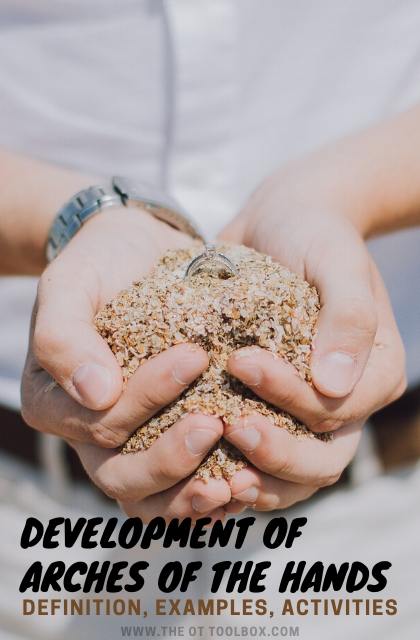
Arches of the hands- Like web space, the arches of the hands are an anatomical feature, but we can develop them through hand strengthening activities and exercises. There are three main arches of the hands–two that run from the hypothenar eminence (ulnar side) to the thenar eminence (radial side), and one that runs transversely up the middle of the palm. Of the two arches, one runs just below where the fingers meet the metacarpals, and the other on the bottom of the palm from the outside heel of the hand to just under the thumb.
The main purpose of these arches is to allow for opposition of the thumb to the fingers, and for various power and precision grasp patterns. These arches are also what allow you to form a functional “C” shape with your hand.
When the arches are underdeveloped, this functional position appears “flat”, thumb to finger opposition and dexterity skills decrease.
The arches are needed for endurance in tasks like coloring, writing, and other fine motor activities. The curved palm is needed for tasks which require the palm to cup items such as small objects, coins, beads, water, or other things which can be held in the palm of a “cupped” hand. Here is an activity to improve arch development and intrinsic hand strength.
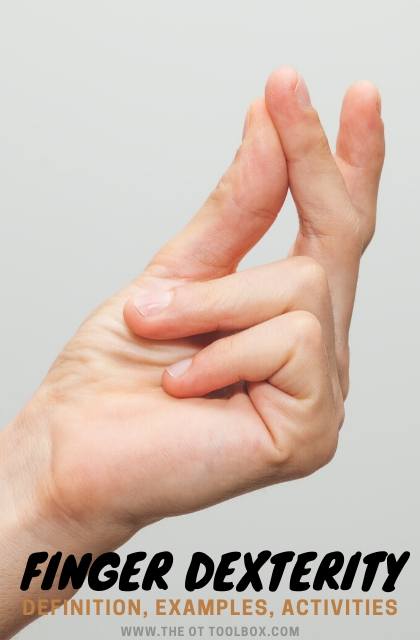
Dexterity- One of the most commonly known fine motor skills is dexterity. Dexterity is our ability to move our fingers in novel patterns of finger isolation and opposition to complete a variety of tasks throughout our day. Tasks like opening the toothpaste, eating cereal with a spoon, zipping a coat and many more. Without the good in-hand manipulation skills, web space and developed arches of the hands, dexterity skills are negatively impacted.
Dexterity is one of the areas of fine motor skills that is most likely to noticed when its impaired due to its high level of need during daily activities.
Sometimes we see kids who write using their whole arm or wrist. They move the pencil or crayon with the forearm and don’t move the fingers to color or write. Distal dexterity of the fingers and mobility of the hands is needed for precision. Here is an activity for dexterity.
A Final Note on What Fine Motor SKills Are
After reading through all of these details on what makes up fine motor skills, it can be overwhelming to think about where to begin. Don’t worry though! Our fine motor skill set is a complex and interactive skills that support many of our daily activities. When they are impaired or challenges are noted, identifying the area of skill break down is helpful when providing intervention and treatment. Take a look on this website for many fine motor activities that can be fun ways to work on specific skills.






